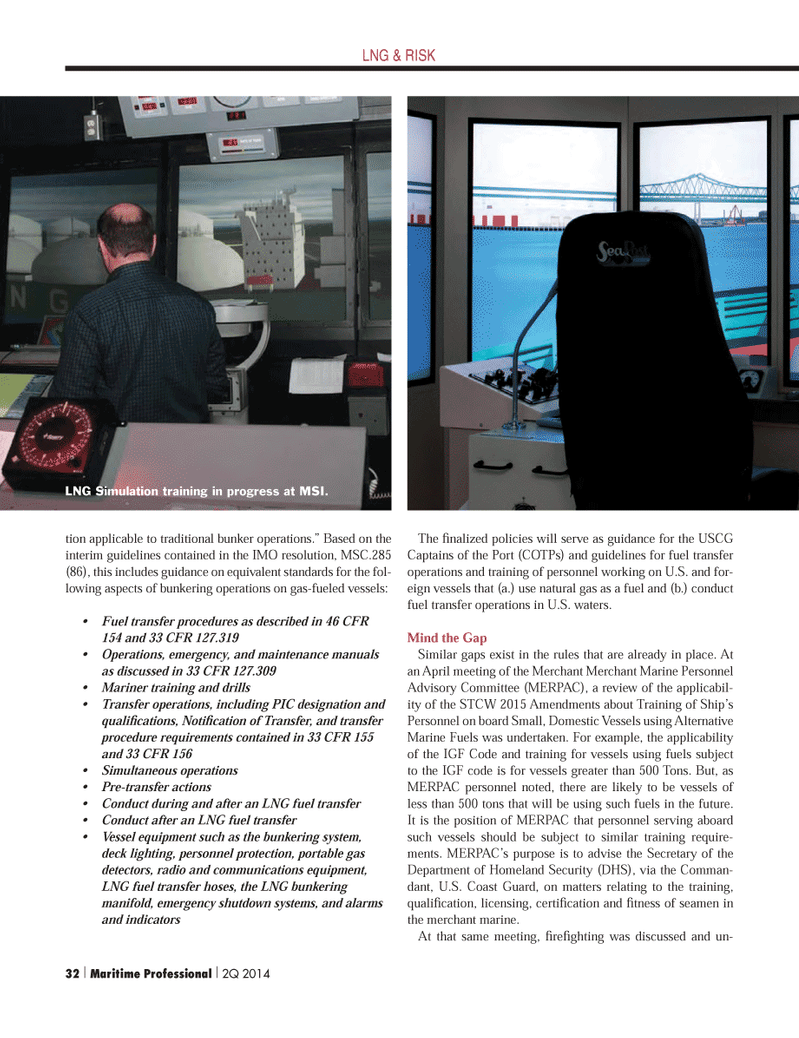
Page 32: of Maritime Logistics Professional Magazine (Q2 2014)
Maritime Risk & Shipping Finance
Read this page in Pdf, Flash or Html5 edition of Q2 2014 Maritime Logistics Professional Magazine
tion applicable to traditional bunker operations.” Based on the interim guidelines contained in the IMO resolution, MSC.285 (86), this includes guidance on equivalent standards for the fol- lowing aspects of bunkering operations on gas-fueled vessels: Fuel transfer procedures as described in 46 CFR 154 and 33 CFR 127.319 Operations, emergency, and maintenance manuals as discussed in 33 CFR 127.309 Mariner training and drills Transfer operations, including PIC designation and qualifi cations, Notifi cation of Transfer, and transfer procedure requirements contained in 33 CFR 155 and 33 CFR 156 Simultaneous operations Pre-transfer actions Conduct during and after an LNG fuel transfer Conduct after an LNG fuel transfer Vessel equipment such as the bunkering system, deck lighting, personnel protection, portable gas detectors, radio and communications equipment, LNG fuel transfer hoses, the LNG bunkering manifold, emergency shutdown systems, and alarms and indicators
The fi nalized policies will serve as guidance for the USCG
Captains of the Port (COTPs) and guidelines for fuel transfer operations and training of personnel working on U.S. and for- eign vessels that (a.) use natural gas as a fuel and (b.) conduct fuel transfer operations in U.S. waters.
Mind the Gap
Similar gaps exist in the rules that are already in place. At an April meeting of the Merchant Merchant Marine Personnel
Advisory Committee (MERPAC), a review of the applicabil- ity of the STCW 2015 Amendments about Training of Ship’s
Personnel on board Small, Domestic Vessels using Alternative
Marine Fuels was undertaken. For example, the applicability of the IGF Code and training for vessels using fuels subject to the IGF code is for vessels greater than 500 Tons. But, as
MERPAC personnel noted, there are likely to be vessels of less than 500 tons that will be using such fuels in the future.
It is the position of MERPAC that personnel serving aboard such vessels should be subject to similar training require- ments. MERPAC’s purpose is to advise the Secretary of the
Department of Homeland Security (DHS), via the Comman- dant, U.S. Coast Guard, on matters relating to the training, qualifi cation, licensing, certifi cation and fi tness of seamen in the merchant marine.
At that same meeting, fi refi ghting was discussed and un-
LNG & RISK
LNG Simulation training in progress at MSI. 32 | Maritime Professional | 2Q 2014 18-33 Q2 MP2014.indd 32 5/16/2014 2:54:06 PM

 31
31

 33
33
